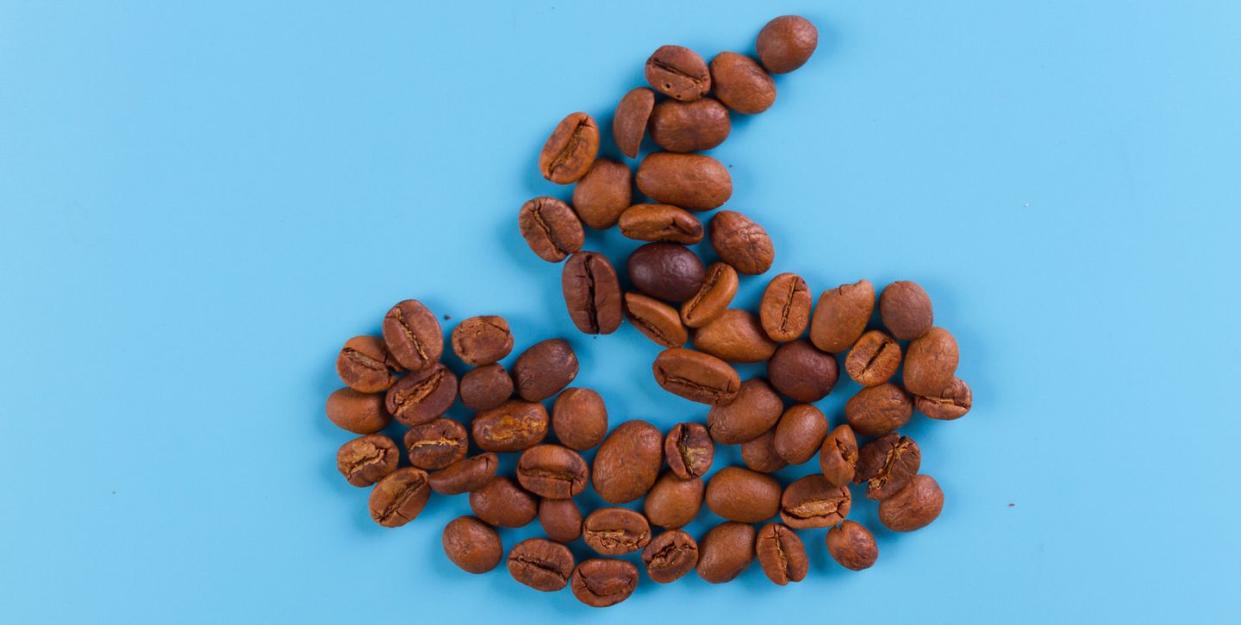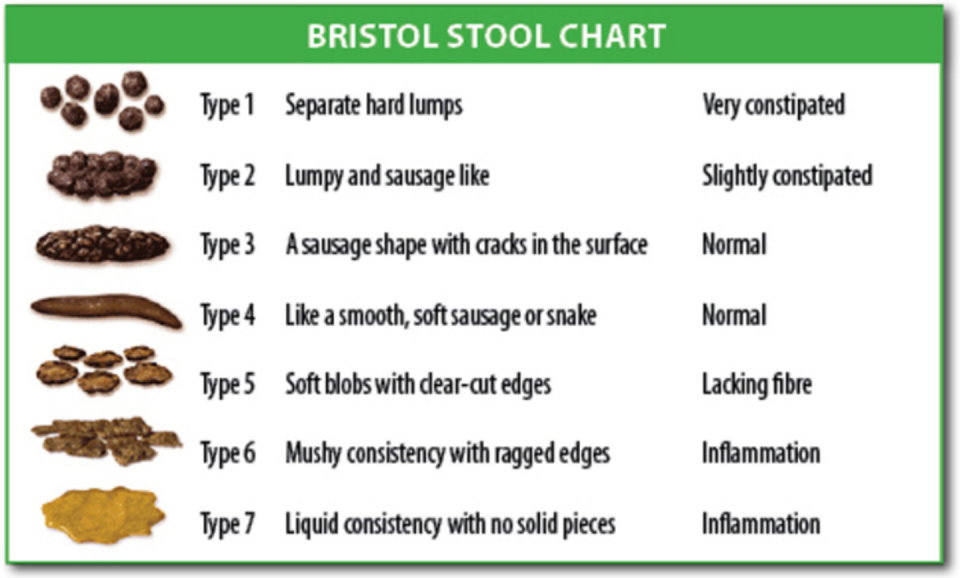7 Textures of Poop and What They Mean (Because We Know You’re Curious!)

"Hearst Magazines and Yahoo may earn commission or revenue on some items through the links below."
Everyone poops—but that doesn’t mean we like to talk about it or acknowledge it in any way, shape, or form. Still, it doesn’t change the fact that sometimes a trip to the bathroom can leave us scratching our heads, wondering if the latest bowel development should be cause for concern. The Bristol Stool Chart is a helpful diagnostic tool that helps us break down why our poop takes its many shapes and forms, and when your poop is reason enough to see a doctor. Doctors can also use the tool as a practical guide in assessing how long a stool has spent in the bowels.
“Your bowel movements are the only real marker you have about what your GI health is like,” says Anish Sheth, M.D., a board-certified gastroenterologist at Penn Medicine’s Center for Digestive Health. Getting familiar with what’s normal for you in terms of stool shape, consistency, and texture can help you better take care of your body and pick up on any changes that may signal a bigger problem.
If something is off with your digestive health, being able to reference the Bristol Stool Chart ensures that both you and your doctor are on the same page about what, exactly, is landing in the toilet, without having to bring in a stool sample. Here’s what you need to know about this handy reference guide—and what your poop says about you.
What is the Bristol Stool Chart?
The Bristol Stool Chart, aka the Bristol Stool Form Scale or Bristol Stool Scale, is a visual guide to the different types of poop you can have. “We use it to classify stools and the character of stools,” says Rudolph Bedford, M.D., a gastroenterologist at Providence Saint John’s Health Center in Santa Monica, CA.
The chart is “well-validated” and breaks poop down into seven different types based on consistency, “from hard and pellet-like to soft and mushy,” says Randall Meisner, M.D., a gastroenterologist with Spectrum Health. “It describes a wide variety of what are considered normal bowel movements,” he adds.
What’s the purpose of the Bristol Stool Chart?
The Bristol Stool Chart helps doctors and patients speak the same language when talking about bowel movements, explains Lukasz Kwapisz, M.D., an assistant professor of medicine—gastroenterology at Baylor College of Medicine. “It really helps clinicians—in most cases, gastroenterologists or primary care physicians—to have an understanding of what type of bowel movements patients are having,” he says. “This allows the doctors to tailor a treatment plan to improve the consistency and help alleviate patients’ concerns.”
Typically, patients are shown the chart and asked to ID the number of the stool they’ve been experiencing. “It’s hard to describe poop,” points out Ellen Stein, M.D., a gastroenterologist and associate professor at Rutgers Robert Wood Johnson Medical School. “It’s a lot easier to point to it.”
How is poop classified in the Bristol Stool Chart?
Under the Bristol Stool Chart, poop is classified into seven distinct categories. Here’s a breakdown.

1. Separate lumps
Hard poop will often come out in separate lumps and can be painful to pass. When poop is this texture (similar to pebbles), it’s a sign that it sat in the large intestine and colon for an extended period of time. In other words, this type of stool often signals that you’re constipated.
If this is commonly what you see in the toilet—and you aren’t suffering from another illness that comes with this side effect—you may have a gastrointestinal condition called chronic idiopathic constipation, or CIC. Drinking more water, making exercise part of your daily routine, and slowly adding more fiber to your diet may help.
2. Sausage-shaped but lumpy
Firm stools that are connected but still lumpy can also be a sign of constipation. This signals that your waste has hung around in the intestine long enough to become dried out, but not so long that it’s dry enough to break into smaller pieces, according to UnityPoint Health experts. You can try eating more of these foods to relieve constipation to get things moving, but if nothing seems to help, ask your doc if a prescription medication is a good fit for you.
3. Sausage-shaped with cracks
If this describes what you’re used to seeing when you go to the bathroom, then congrats! This is considered to be a healthy stool, according to the Bristol Stool Chart, a tool used by medical professionals and dietitians. The cracks, however, do indicate that you may be a bit dehydrated. Gastroenterologist Robyn Karlstadt, M.D., suggests drinking six to eight 8-ounce glasses of water daily to keep your GI health in tip-top shape.
4. Sausage-shaped, smooth, and soft
Doctors consider this type of stool (think: sausage- or snake-shaped) to be the gold standard—especially when it’s also medium to light brown in color and remains intact as it is flushed. If this is what your poop looks like, give yourself a pat on the back because it’s a clear sign you’re eating a wholesome diet and staying nice and hydrated.
5. Soft blobs with clear-cut edges
This is considered to be a slightly loose stool, but it’s fairly common for folks who have bowel movements two or three times a day, typically after eating a main meal, UnityPoint Health medical experts say. (If this is normal for you, and it’s soft and passes comfortably, consider it A-OK.)
6. Fuzzy or fluffy pieces with ragged edges
When waste passes through the colon quickly, this texture of poop is often the result.

Gain *unlimited* access to Prevention
According to the Bristol Stool Chart, fuzzy, jagged pieces may indicate inflammation of the bowel or an inflammatory bowel disease like ulcerative colitis or Crohn’s disease. It can also indicate a major change in your diet. Check in with your doc to make sure there’s no reason to be concerned. (Sure, it can feel like an embarrassing conversation, but it’s always best to err on the side of caution and physicians used to these types of questions.)
7. Watery (liquid poop)
This advanced stage of diarrhea occurs when the small intestine is irritated. There are numerous causes of this type of stool, including viruses and bacteria, digestive disorders, and lactose intolerance. Sometimes eating or drinking things with lots of fructose or artificial sweeteners, or starting a new medication can be the cause, according to the Mayo Clinic. If your diarrhea lasts more than two days, contact your doctor.
What is the ideal stool type?
Everybody has their own stool consistency that’s considered “normal” for them. But, in general, a type 3 or 4 is best, Dr. Stein says. “Four is kind of a soft serve consistency,” she explains. “It’s easy to pass and smooth. That’s considered ideal.”
Having this poop indicates that you’re well hydrated, but it’s not as liquid as diarrhea, which suggests you’re passing things too quickly through your GI tract, she says.
When should you visit your doctor?
Again, everyone’s normal bowel movements are different. Because of this, experts say it’s tough to say for sure what type of poop should send you running for the doctor.
“A good general rule of thumb is that if there is a change in bowel habits—whether stool frequency or consistency—that is ongoing for more than a few days, this would be a good time to see your doctor to discuss,” Dr. Kwapisz says. But, he adds, if there are “red flag” symptoms like bloody poop, a fever, unexplained weight loss, uncontrollable vomiting and diarrhea, or not being able to poop at all, you should see your doctor sooner rather than later.
You Might Also Like

